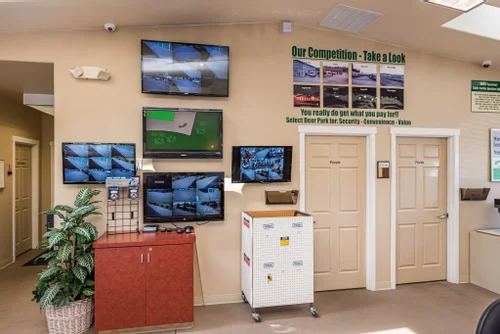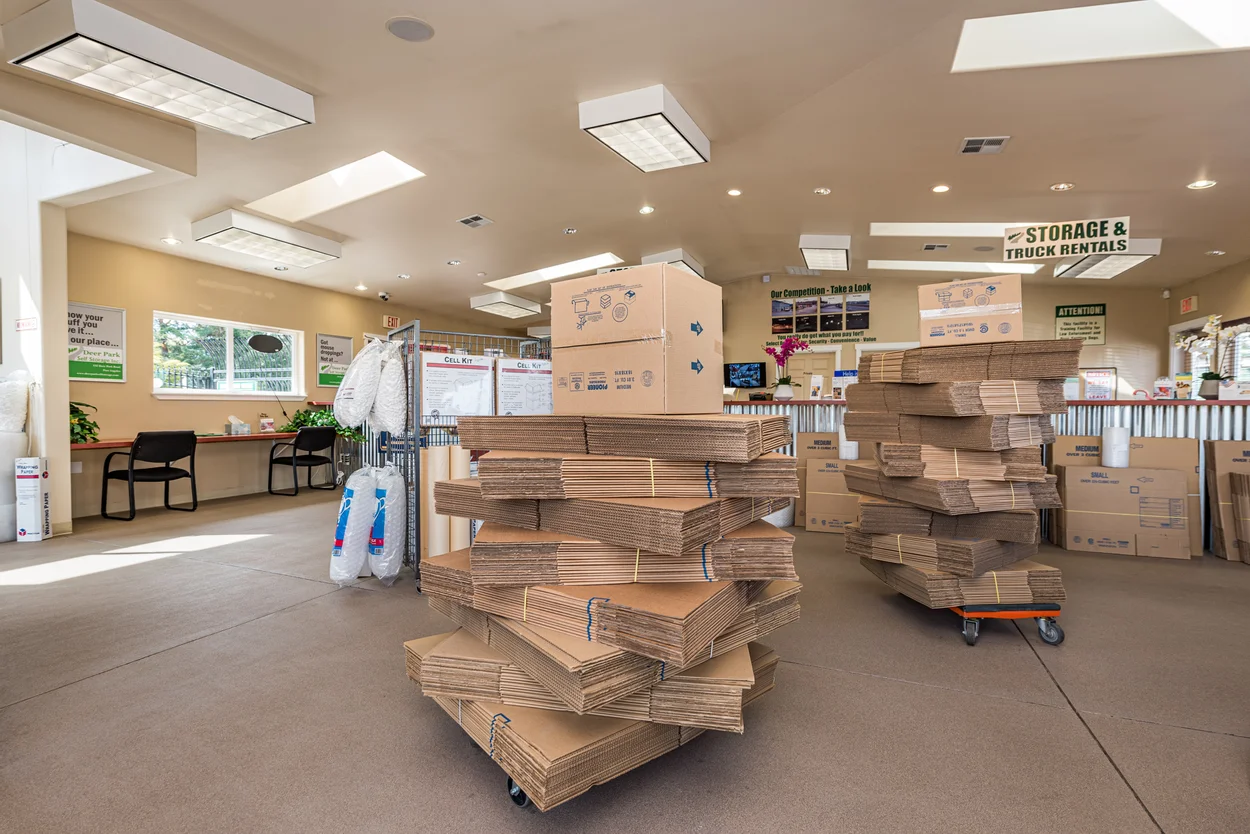Deer Park Self Storage | Tips and Tricks Guide
Everything you need to know on packing and organizing your storage unit.
A New Kind of Self Storage
Trust Deer Park Self Storage to be there for you whenever you need extra time, space, and storage solutions to help you manage whatever comes next in your life. Choose from a variety of unit sizes from a 5’x5′ (25 sq. ft.) up to 11’x40′ (440 sq. ft.) Most unit sizes come in both non-climate control or climate-control options.Let us take the stress out of your next move. Choosing the right size unit can save you time and money. Check out our articles for everything you need to know on how to store everything from appliances to bedding and furniture to recreational vehicles.

Tips and Tricks Guide
Bedding, Clothing, Curtains, Drapes and Linens
Fabric items like clothing, curtains and drapes are best if stored on hangers. If hanging cartons are not available, such items should be carefully folded and stored in dresser drawers or cedar chests along with bedding and linens.
Make a List and Plan Ahead
Create a list of labeled boxes for easy reference. Color coordinating or numbering each box is a great trick to stay organized.Also, gather up plenty of sturdy, corrugated cartons, packing paper, bubble wrap, sealing tape and marker pens, along with any furniture covers or shelving you intend to use in your storage unit.
Appliances
A refrigerator or freezer should be thoroughly dry and stored with its door slightly ajar. Some goods can be stored inside large appliances. Be sure to make a note if you place anything inside. Boxes can be stacked on top of stoves, refrigerators, and freezers. Make sure that stoves and cooking equipment are clean and dry before you pack them.
Keep, Give, Trash
A month before you move is a great time to clean house. Plan a trip to your local donation center with old clothes, toys or sporting equipment, garage and lawn gear. If something is broken, expired, or no longer of use, lighten your load and throw away what you won’t be taking with you.
Dishes and Glassware
Place a layer of packing inside the bottom and the top of boxes containing glassware. All glass items should be individually wrapped: nest cups and bowls together and stand plates, saucers, and platters on their edge. Wrapped glasses should be placed near the top of cartons. Again, fill all open pockets with packing paper. Label all boxes containing glassware and do not place heavy items on top.
Pack Efficiently
Pack as much as you can in the same size boxes. Fill boxes tightly, but take care to neither overpack nor underpack. (Bulging cartons tip when stacked, while half full boxes tend to collapse). Use wadded up newsprint, bubblewrap, rags, towels, or blankets to fill in empty spaces. For maximum protection seal cartons with tape.
Furniture
Place a pallet, corrugated cardboard mat, or plastic sheet on the floor before placing furniture. If possible, stand sofas and mattresses on end. Disassemble beds and tables and wrap table legs in paper. If a table will not disassemble, place padding on the floor and place the table on its top with the legs pointing up. Use dresser tops for stacking cartons and dresser drawers for linens or small, delicate items. Keep upholstery off the floor. Most lightweight chairs can be stacked “seat to seat” or placed upside down on tables, which cannot be disassembled. Finally, place a light cotton dust cover, such as a bed sheet, over your furniture.
Manage Weight
Pack heavy items such as books and tools in small boxes. For easier handling limit the weight of all cartons, regardless of size, to 30 lbs. or less.
Books and Documents
Pack books flat to protect the spines. Do not place boxes directly on concrete floors, but use pallets or skids to prevent moisture absorption. Use packing to fill all empty pockets in each box. Do not pack fragile items in the same box with books and do not overload.
Label All Boxes
Clearly label boxes so you know their contents, and keep a list (as well as pictures and descriptions) at your home or office for reference. Mark clearly all boxes containing fragile items.
Clean Stored Items
Clean and dry appliances before storing. Secure all movable parts with paper, or wedge and wrap a paper pad around each item for protection. During transport tape all doors shut, but remember to wedge them open for storage.
Holiday Decorations
Save the original cartons that contained delicate ornaments. Pad the ornaments with packing paper or newsprint. Wrap strings of lights around a piece of cardboard before placing in a carton lined with packing paper.
Placement
Store items you’ll need most often at the front of the unit. When you pack your storage unit, create a center aisle for access to all items.
Mirrors, Windows, Glass Sheeting and Screens
These items should be stored on edges, not flat. We offer a selection of mirror/picture boxes that can be purchased at our office.
Preparation Prior
to Your Move
- Buy packing supplies
- Start packing boxes as soon as possible
- Send address change cards
- Get copy of school records
- Have clothing dry cleaned
- Check on items in repair shops
- Notify utilities and telephone companies
- Set a date for utility disconnection and hookup
- Return borrowed items and things you’ve lent out
Tools
Metal tools should be cleaned and wiped with a rag containing a few drops of machine oil to prevent rust. Long handled tools such as rakes, shovels and hoes should be clean, lightly oiled and tied in bundles.
Use Drawers
Use bureau drawers to store small, fragile items. Secure items in drawer by filling empty spaces with towels or packing paper.
Bicycles and Other Metal Items
To avoid rust, wipe all metal surfaces with a rag containing a few drops of machine oil.
Cover Chairs
Protect chair legs by wrapping them in packing paper. Leave slipcovers on upholstered chairs and cover them with plastic chair covers.
Mark Your Calendar
Make a timeline leading up to moving day for cleaning out, labeling, and organizing your life before you move. Take a little time each week or day to check off the list, one room or closet at a time.
Use Paper for Breakables
Use lots of paper to pack dishes and glassware. Place a layer of packing paper inside the bottom and top of cartons. Wrap each dish and glass separately and cushion them with crumpled paper. Plates are best stacked on edge. Pad mirrors and paintings with paper. Place them in special mirror packs or large boxes; mark boxes.
Don't Rush
Taking time to carefully load your storage space will ensure the best results for your belongings.
Separate Lamps and Lampshades
Wrap large lamp bases in padding and wrap smaller lamps completely before placing them in boxes. Pack delicate lamp shades separately. Do not use newsprint to wrap lamp shades or any other goods that may be damaged by ink stains. You can purchase unprinted wrapping paper, foam wrap or bubble wrap at our location to help protect delicate items. Do not store heavy items on top of cartons containing lamps or lampshades.
Leave Some Room
Leave air space around the perimeter to aid ventilation. Boxes of the same size make for easy stacking.
Clear a Path
Leave a walkway to the rear of your space for convenient access to all items.
Don't Put Boxes on the Floor
Do not place boxes directly on concrete floors, but use pallets or skids to prevent moisture absorption.
Think Outside of the Box
Using plastic storage containers is a great option for accessibility without the hassle of packing tape.
Use Quality Materials
Use high-quality packing boxes designed especially for the job and seal them completely with packing tape.
Moving Day!
- Discard all flammables, such as paint and gasoline
- Finish packing. Leave out items for moving day
- Empty and defrost refrigerator and freezer
- Have everything packed, except bedding
- Pick up ice and beverages
- Strip beds. Cover mattresses with mattress bags unless they are going in storage
- Turn water and lights off
- Lock windows and doors

